WALK IN HAJDÚBÖSZÖRMÉNY
The Bocskai square
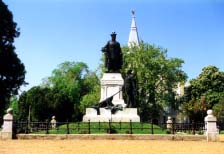
The Bocskai square took shape in the intersection of the four avenues cutting across Hajdúböszörmény. It gained its present form after development and considered townplanning through centuries. Already in the town-development scheme in the 18-19th centuries there was a plan to establish the architectural consistency of the square. The square-arrangement that determined the present aspect of the square had started in the second half of the 19th century. In this huge reconstruction János Balthazár, the engineer of the town and Gábor Sillye, the Commissioner of Hajdú District played a great part.
The protestant church
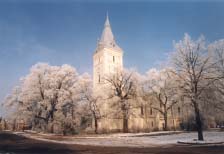
The protestant church located in the middle determines the appearance of the Bocskai square. The former church was probably built at the end of the 15th century in gothic style and it was surrounded by a defensive wall. The present monumental building took its actual shape under the renovation between 1880-82. At that time the defensive wall was demolished as well. The internal and external appearance of the church uniform, they bear the marks of the Romanticism.
The residence of Hajdú District
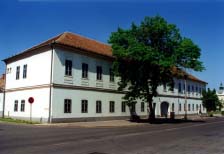
The former residence of Hajdú District is placed on the southern side of the Bocskai square. The building is one of the most important architectural monuments of this region (Alföld), it's the oldest secular public building of the county. It was built between 1762 and 1871 in three phases. The third phase was connected to the square-arrangement. After Hajdú District was terminated (1876) the building was used for different services. Nowadays it is the seat of the Museum Hajdúsági and the Court of Justice of the Town.
The István Bocskai Secondary School
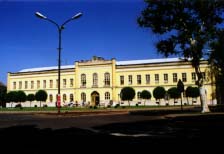
"BUILT FOR THE SCIENCES BY THE COMMUNITY OF TOWN HBÖSZÖRMÉNY AND THE NOBILITY OF HAJDÚS MDCCCLXIV."- can be read on the tympan of the building. Even before this grammar school there was already a school on this place working as the particle of the Debrecen Calvinist College. It was mentioned first in 1621. The calvinist hajdú-communities payed a great attention to the education from the very beginning. The construction of the new school took place in 1864-65 by the second plan of Imre Vecsey, an architect from Debrecen. The two-storied, wide-facaded, U-shaped building bears the marks of the Romanticism and determines the townscape.
The City Hall
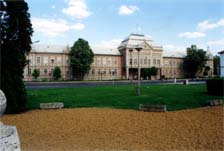
The City Hall can be found on the eastern side of the Bocskai square. It was built in 1905-07 by the plans of Károly Dobay. The two-storied, U-shaped building reflects the style of the late Eclecticism and follows the formal traditions of the old town- and county-halls. There is an arcade adorning it in the front. From the doorway a decorous flight of stairs goes through the spacious staircase to the council-hall on the second floor. There are marble tables attached to the walls with the names of the casualties of the 1st World War engraved.
The Bocskai Statue
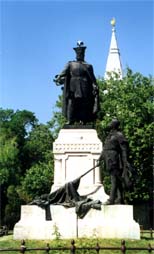
The Bocskai Statue can be found in the focus of the Bocskai square. It's the work of the sculptor Barnabás Holló. It was set up in 1907. The two-figure composition represents István Bocskai, the Prince of Transylvania, as he is handing the Charta of 1605 to the hajdú-valiant in front of him.
The Dancing Hajdús - group
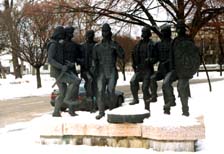
In the side of the protestant church on the Bocskai square can be found the group of statues, the work of the sculptor István Kiss that represents the hajdú-valiants dancing together. The composition of the seven figures symbolizes the seven hajdú-towns. These are Böszörmény, Polgár, Szoboszló, Dorog, Hadház, Nánás and Vámospércs. The millstone placed in the front represents the union of these hajdútowns.
The Skanzen
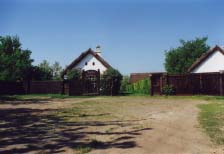
The old houses at 92-100 Polgári street preserve the features of the folk architecture in Hajdúböszörmény. Nowadays they serve as etnographic museum and camping. The houses in Hajdúböszörmény usually were built of adobe and roofed with thatch in the early times. They were single-floor houses divided in three parts. The hall served as kitchen as well and there was a room on both sides.
The Miklós Káplár Memorial House
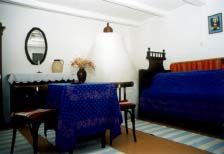
The building was the home of painter Miklós Káplár. In 1978 the City Hall has opened a memorial museum in the house. It was built in 1853 and bears the marks of the folk architecture of Hajdúböszörmény. Káplár was an authentic illustrator of the worldfamous Alföld (Great Hungarian Plain), people of Alföld and herdsmen's life. There are about 40 pictures and a collection of various objects as a part of his legacy can be seen in the memorial house.
Memorial of the 1st World War
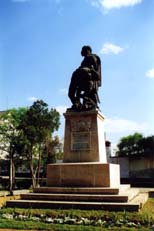
The statue placed in the park on Kálvin square is made by sculptor István Gách. It was erected in memory of those almost two thousand inhabitants of Hajdúböszörmény, who died in the 1st World War. It was dedicated in 1927 by the Governor Miklós Horthy.
Memorial of the 2nd World War
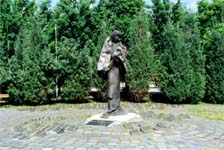
The statue of the world-famous sculptor Imre Varga is placed behind the Gábor Sillye House of Culture and Community. There is a woman with flowers in her hands standing above the stylized map of Europe. Her face reflects sorrow and pain. There are brass plates placed around her with the list of the casualties of the 2nd World War. It was dedicated on the All Saints' Day in 1991.
Memorial of the (17.) Bocskai hussar regiment
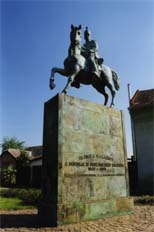
The composition of Éva Varga is placed on Ady square. It preserves the memory of the (17.) Bocskai hussar regiment, which was organized by Gábor Sillye, the Commissioner of Hajdú District at the fight for freedom in 1848-49.
Millecentenary Memorial
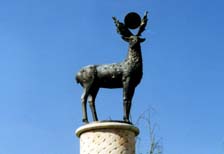
It was dedicated in 1996, made by Tibor Horváth.
Bust of Gábor Báthori
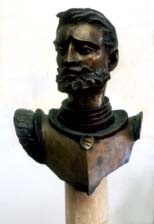
The bust of Gábor Báthori, the Prince of Transylvania, can be seen in the doorway of Hajdúsági Museum. It was him who resettled the hajdús from Kálló in Böszörmény with his Charta on the 13th of September 1609, because they were in constant fight with the imperial army. The bust was made by sculptor Tamás Fekete. It was dedicated on the 13th of September 1991.
Statuepark in the garden of the museum
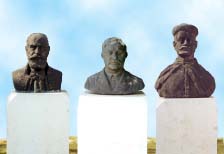
In the courtyard of Museum Hajdúsági there are statues of artists, scientists and prominent characters of history, who were related to the Hajdúság and Hajdúböszörmény (like Miklós Káplár, Mihály Csokonai Vitéz, István Győrffy, Péter Veres, Gábor Sillye, Gábor Bethlen, István Bocskai, Jenő Király).
The memorial plaque of Mihály Csokonai Vitéz
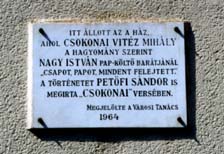
The memorial plaque of the famous hungarian poet can be found on the wall of the elementary school Nr. 2 on Bocskai square. Once the vicarage of the Protestant Church was on the place of the school. At that time Mihály Csokonai Vitéz often visited István Nagy, the priest of the church. Sándor Petőfi mentions one of his visits in the poem "Csokonai".
The protestant church on the Kálvin square
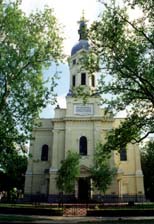
The second protestant church of Hajdúböszörmény was built in the style of the late Eclecticism. It was dedicated on the 19th of November 1899. It was built by Richárd Röszler, engineer and building constructor.
The greek catholic church
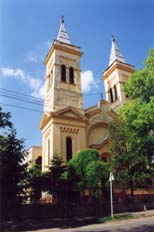
The construction of the two-towered church was dragged on because of the mistakes in planning and executing. It was consecrated on 8th of May 1898. The old nave was recently pulled down because of static errors and was rebuilt.
The roman catholic church
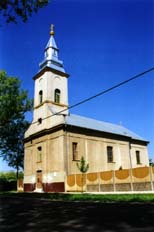
It was built in the 1860s. Its small size represents the small number of the roman catholics and shows that Hajdúböszörmény was mostly protestant in belief.
The baptist bethesda
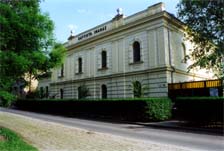
The chapel was built from the donations offered by the congregation in 1895.
The synagog
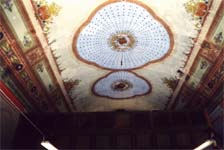
The church was built in 1863 following the orthodox jewish religious laws.
Cemetery art I.
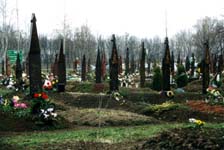
One of the characteristic features in the cemetery art of Hajdúböszörmény is the boat-shaped gravepost. The willow and the sun appear as decorative motifs.
Cemetery art II.
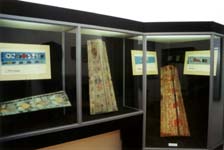
Until the end of the 19th century the joiners in Hajdúböszörmény had made coffins with painted tulips in their workshops. Like the painted furniture, which was wide-spreaded in this region, there were tulips and other flowers painted as decorative motifs on the coffins.
The ruined church in Zelemér
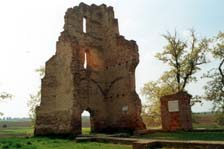
In the outer area of Hajdúböszörmény, about 10 kilometres from the town can be found our oldest monument, the ruined church in Zelemér. Nowadays only the remains of the church can be seen that was built in gothic style. It was first mentioned in 1332.
Nature Photos
Snapshots
about
Böszörmény
Photos about
the Economy